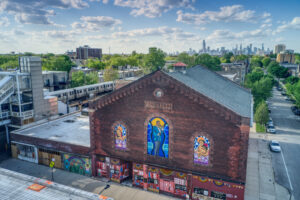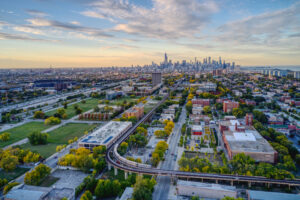Bronzeville: The “Black Metropolis” and Harlem of Chicago
by Dr. Denise O'Neil Green | February 28, 2023 10:00 AM

During the pandemic and lockdowns, I rediscovered Chicago and where I’m from. In Canada, people always ask you: “Where are you from?”. I would be a little salty because I felt I didn’t have a good answer. Of course, I would say: “I’m from the United States”, and most times “Chicago”, without having much knowledge of its Black history.
However, when I had time on my hands because folks had to pretty much be indoors, my spouse and I came across a series of WTTW (Window To The World) documentaries on Chicago and my connection was rekindled when I learned about Bronzeville. I started looking at dates, maps, and my family’s migration story, and now I can say much more about this awesome neighborhood and its rich history.
As a proud 4th Generation Chicagoan, I’ve been exploring where I’m from and the history of Bronzeville: Chicago’s Black Metropolis. Many folks know about Harlem, but do you know about Black Chicago – Bronzeville – and what it contributed to Chicago and gave to the world? So, in celebration of Black History Month, I’m sharing a few facts about where I’m from, what happened there, and the fantastic things generations of Black Chicagoans accomplished.
Why was it called “Bronzeville”? Before the migration of Black people from the South to many different urban centers, such as Chicago, the area was named after Senator Stephen Douglas of the Lincoln-Douglas Debates, who developed the area. But after over 50,000 Black migrants moved to the city and were relegated to live in one designated area, it was later called “Bronzeville” to reflect the color of the folks who lived there. Over 500,000 eventually migrated to the area.
Due to restrictive covenants that forced Black migrants to live in a small band/strip of land, “Bronzeville” became “The Black Metropolis”. Out of necessity, there were banks, restaurants, stores, theaters, and a hospital where Black nurses were trained and doctors practiced. Also, Anthony Overton launched the first Black-owned insurance company in the North.
The dollar circulated through Bronzeville 8-9-10 times before it left the community.
When learning all this history about where I’m from, I recalled going to Overton Elementary School as a little girl. When I looked it up, I realized Overton Elementary School was in Bronzeville. It opened in 1963, closed in 2013, was designed by Perkins & Will and is a “superb example of midcentury modern architecture”. Who knew?

There are many notable people who lived in Bronzeville, including Nat “King” Cole, Jack Johnson, Ida B. Wells, and Mahalia Jackson. The first African American department store in the United States was in Bronzeville. The Negro League started in Bronzeville, and the first open heart surgery was done in Bronzeville.
Carter G. Woodson, known as the “Father of African American History”, visited Bronzeville, and his experiences in The Black Metropolis inspired him to co-found with four others, “The Journal of Negro History”. When I was a high school student, after my classes, I would go to the Carter G. Woodson Regional Library and study in the wing of the library where many of his writings were housed in the Vivian G. Harsh Research Collection; Harsh was Chicago’s first Black Librarian.
After learning all these things and more, my heart swelled with pride, because I come from a place where my great-grandparents, grandparents, and parents lived to have a better life.
My old childhood neighborhood is now the Bronzeville Black Metropolis National Heritage (designated as of December 2022). So, now when I’m asked: “Where are you from?”, I have a definitive answer: Bronzeville: The Harlem of Chicago. Make sure you learn more and visit this wonderful neighborhood when you are able to.
What about you? Do you have any interesting stories or facts to share about Bronzeville?
Let’s share and connect. I’d love to hear your thoughts.
Reference:
The Bronzeville Neighborhood (Chicago: South Side): https://interactive.wttw.com/southside/near-southeast/bronzeville
Source URL: https://institutionaldiversityblog.com/bronzeville-the-black-metropolis-and-harlem-of-chicago/